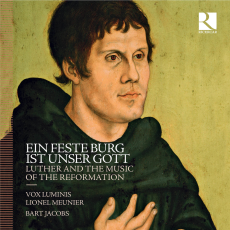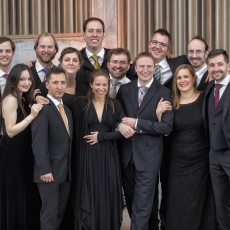Vox Luminis - Ein feste Burg ist unser Gott - MusicWeb International
Vox Luminis have put together a carefully curated pair of discs that focus on different aspects of Luther’s impact, and which bring into focus a whole range of composers that I’d never heard of but whose work I very much enjoyed. Performances are excellent throughout, and there’s such variety that the appeal deserves to go far beyond the merely historical.
The first disc focuses on how Lutheran composers wrote music to cater for every season of the church year, and it includes music for every feast from Advent through to Trinity and everything in between. Everything in the set is pre-Bach, so you’ll have the joy of discovery throughout, and the same is true of the second disc, which showcases ways in which Lutheranism changed the church’s liturgy. Much more than the Swiss reformers, Luther maintained his love of much Catholic liturgy, and saw much of it as helpful, so long as it was reformed by, say, translating it into the vernacular.
So the two discs give us a tour through the impact of Luther’s ideas and a fascinating insight into their impact on music which, of course, he loved, much more so than Zwingli or Calvin who banished it from their reformed Protestant services.
There is, therefore, a feast of musical treats on offer here. Maybe not all of the composers are of top drawer quality, but there are some wonderful things. Michael Altenburg’s setting of Nun komm der Heiden Heiland is neo-Bachian in its use of multi-layered polyphony, yet it retains the crystalline clarity of the Renaissance wonderfully. Andreas Hammerschmidt’s Christmas motet, Freude, große Freude is as joyful as its name suggests, bounding lightly across the stave, and after it Praetorius’ Es ist ein Ros’ entsprungen is a marvel of simplicity and familiar beauty. His setting of the Nunc Dimittis - in German, of course - is also lovely. Johann Herman Schein’s beautiful two-voice setting of O Jesulein, mein Jesulein thanks the Christ child for his New Year gifts with the directness of genuine devotion, something reiterated by the canonical simplicity of the writing. I also loved the directness of Othmayr’s O Mensch bewein dein Sünde groß, and it’s fascinating to compare that with the airy splendour of Thomas Selle’s Veni, Sancte Spiritus. Scheidt’s various works present a compendium of genres and of moods, and it’s fitting to feature a very direct chorale setting of Luther’s most famous hymn, Ein feste Burg.
The vernacular is at the centre of most of the works on the second disc, of course, and the German Magnificat setting by Schütz is a brilliant example of how appealingly direct the communication of the Biblical message could be when the composer serves the text so effectively. The section on Dogma contains some statements of basic belief, such as the Creed and the Ten Commandments, that are harmonised with such directness and beauty that you can’t help but understand how they would have appealed to ordinary people; and the disc ends with a personal tribute to Luther by Caspar Othmayr, including, amongst another text, Luther’s alleged last words: “Into your hands, O Lord, I commend my spirit.”
Most fascinating of all, however, is the section of the second disc which pre-echoes much better-known later works. We get, for example, three of the same texts that Brahms would later set in his German Requiem, set here by 17th century composers which Brahms may well have studied. He certainly used the same words and ideas, though Hammerschmidt’s Wie lieblich sind deine Wohnungen is incongruously dolorous. Likewise, we get one of the very earliest German Passion settings. This Good Friday tradition was around long before Bach elevated it to its greatest heights, and Joachim a Burck’s Deutsche Passion nach Johannes sets exactly the same Biblical text as Bach in a mere eighteen minutes. He includes no arias or reflections, but it’s much more than the unendlich rezitativ that you might expect. Instead it sets the Biblical text for eight singers (two groups of four) who put it across with admirable directness and, I must say, a great deal of beauty. I found it very compelling and, in fact, rather moving in its simplicity. Yes, Bach would, of course, make it much more expressive, but as a way of reinforcing the story for the illiterate folk of his sixteenth century congregations, Burck must have done a pretty successful job.
Not all are in German, however. Luther approved the use of the Latin Ordinary of the Mass in church, though most often it was only in the form of the Kyrie and Gloria alone. Bach wrote several of these settings, and that of Christoph Bernhard has the directness of Tallis and, indeed, has a good dose of the Renaissance sound world that Vaughan Williams was trying to recreate in his G minor mass.
The organ voluntaries are often marvellous, too. Paul Sieffert’s setting of Puer natus in Bethlehem sounds pleasingly redolent of bourgeois prosperity, and it even uses the organ’s attendant tinkling of bells for a spell. He finds a wonderful stop for the melody of the Passion Chorale in the setting by Delphin Strungk, surely the composer on the set who wins the prize for the best name. Where that is all directness and simplicity, Michael Praetorius’ fantasia on Ein fest Burg builds up an exhilarating cathedral of sound which shows you why he was such an important influence on Buxtehude and Bach. Hieronymus Praetorius’ Fantasia on Christ unser herr zum Jordan kam is simpler in mood but just as impressive.
The performances themselves are also very strong. Vox Luminis live up to their name by providing refreshingly light vocal performances which seem to shimmer and glow. They seem to demonstrate an identification with the text which comes from the heart, and much of their comforting, warm singing feels like an act of devotion, even if it isn’t in reality. There is a closeness and familiarity to the sound, especially the chorales, such as Schütz’s take on Aus tiefer Not, Luther’s version of Psalm 130. Those hymns, and their direct communication between the singer and his maker, were at the very heart of Luther’s reformation, and it’s wonderful to have performances that take them so seriously.
This issue also scores on the historical front. The two CDs come within a beautifully illustrated hardback book, which contains not only the full texts and translations but an essay about the context of the Reformation, together with a track-by-track analysis of all the music. In short, this is a winner all round, and deserves to be taken up by historians and music lovers alike.

